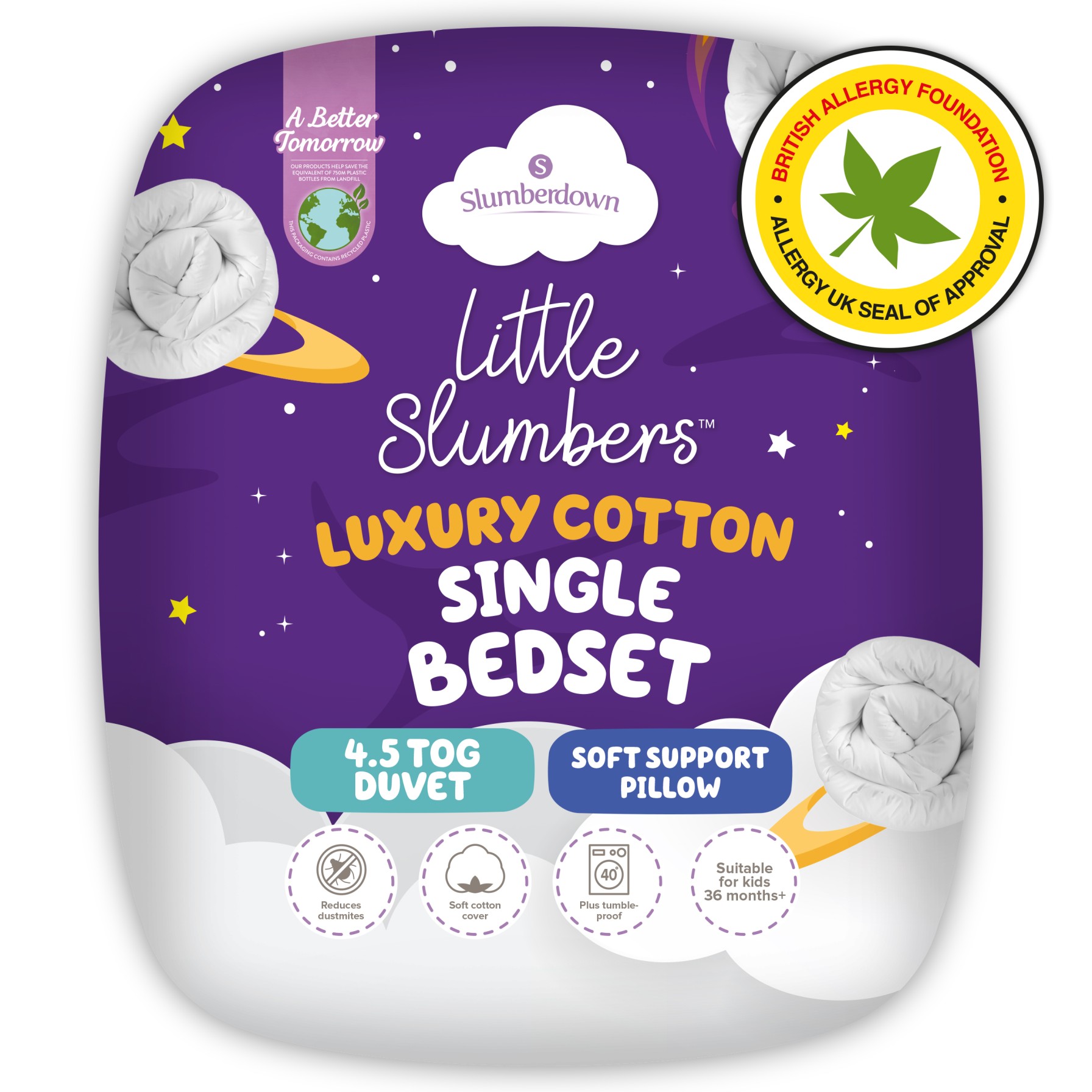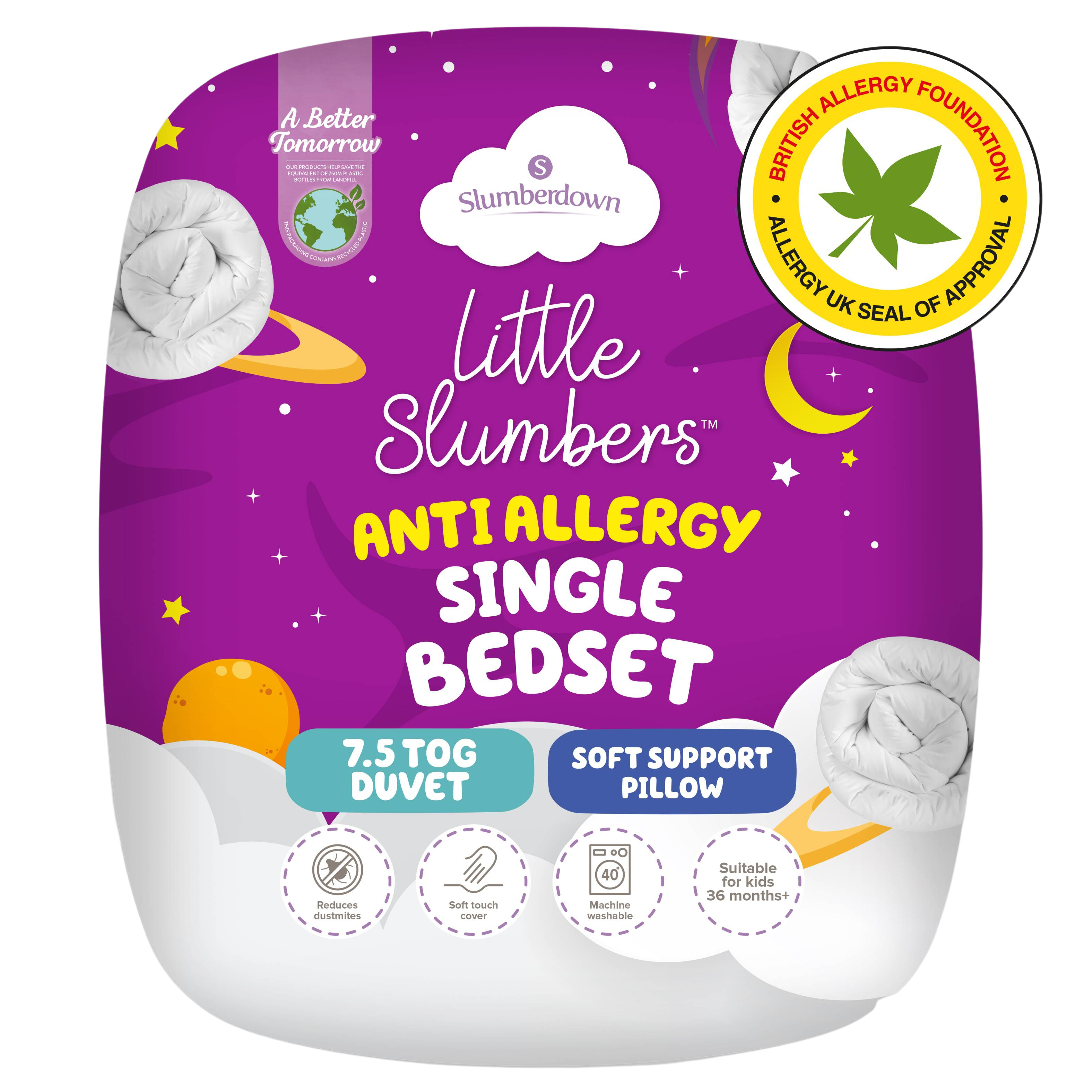Choosing the right duvet for your child is pivotal to ensuring they are comfortable enough to be able to get good quality rest in order to grow and thrive in their early years. Choosing the wrong one might result in your child feeling too cold or too hot as they try to sleep and not being comfortable when they are covered.
A small infant or child’s body temperature can rise quickly, especially when in their cot, because of close contact with the duvet and surrounding materials. Not to mention, new-borns and toddlers cannot regulate their body temperature like we can as adults, making them more vulnerable to becoming too hot and overheating which can be dangerous.
Let’s explore the options available to you, as well as factors to consider when choosing the best duvet for your little one so that they will have a comfortable sleep from now on!
What type of duvet fillings are available?
There are four main types of fillings used in the majority of duvets, including:
– Hollowfibre duvets
– Duck feather/down duvets
– Goose feather/down duvets
– Wool duvets
Hollowfibre
Hollowfibre is usually used as a filling for lightweight tog duvets but is also used for 13.5 and 15 tog duvets that are warmer for winter months. It is very soft and can trap air within its fibres very effectively, making it comfortable and cosy to sleep under.
Hollowfibre fillings are usually the most affordable option, making these duvets a great choice for those on a budget. Moreover, it’s a synthetic man-made fibre that’s hypo-allergenic, meaning it’s unlikely to aggravate any allergies.
Another advantage to choosing a hollow fibre-filled duvet for your little one is that they can often be washed at a higher temperature than their naturally filled equivalents. Washing bedding at 60 degrees Celsius, for example, is the ideal temperature for killing dust mites and bacteria, plus for cleaning away any accidents and stains.
At Slumberdown, our Little Slumbers range is made with hollow fibre as we believe this provides the perfect level of comfort and cosiness without being too heavy or losing its washability.
Duck feather and duck down
These two materials come from the bird. Duck feathers come from the outer layer of the wings and back. Duck down is the inner layer of more insulated feathers to keep the duck and its ducklings warm.
They are both very soft and cosy to sleep on. Generally speaking, these duck feather and down fillings provide moderate warmth, slightly warmer than hollow fibre.
These two fillings can be more expensive than hollow fibre and do lose some of the washability that’s so essential with infants beddings.
Goose feather and goose down
Duvets made from goose feathers and down are naturally warmer and provide extra warmth in winter. They require less filling and still supply the same heat insulation because the feathers are much bigger and better at trapping warm air than duck feathers.
Goose feather and down are typically the most expensive duvet fillings. However, they do offer a lot of warmth during winter months as well as being super soft and long-wearing. Often, goose feather and down will be paired with a more premium cotton cover so they are considered a luxurious choice for duvet filling.
What are the benefits of each type of duvet filling for children?
Hollowfibre duvet fillings are great for children because they are usually very light and do not weigh the child down when they snuggle into the duvet.
Duck feather and down fillings are a good option if you’re looking for a natural filled duvet for your child; they are very soft and warm. Keep in mind that duck fillings can sometimes be heavy because of the increased number of feathers and down needed to fill the duvet to get it up to the required tog weight.
Goose feather and down fillings are more suitable during winter since these can provide deep warmth to keep your child comfortable and cosy during cold seasons. They are the priciest option though, so might not be a viable choice for children’s beds.
Which duvet fillings and togs are best for kids for each season?
One thing to keep in mind is that not all tog duvet fillings will have the same warmth. Although the label might say “duvet tog rating X,” that does not mean it’s the best option for all seasons. For example, a 13.5 tog duvet will provide excellent warmth in winter but might be too warm in the summer months depending on where you live.
Different fillings have different thermal conductivities that determine how well each type traps air. For example, hollowfibre with lower tog ratings is not suitable for winter because its thermal conductivity (warmth) is very low. It cannot trap much warm air, making your child feel cold inside the duvet during wintertime.
Duck feather and down fillings are heavier and easy to compress, allowing the child to generate warmth by themselves inside the duvet. Goose feather and down fillings are naturally warmer and help trap warm air during cold months of the year.
For children, it is also imperative to choose a suitable size of duvet for their bed. A child’s bed is usually smaller than an adult’s bed, so you’ll need to choose the right size for them.
For example, a single duvet can be used on single-size beds smaller than the standard single bed. Duvets that are not made specifically for children’s beds might not fit properly and end up being too loose or too tight after washing. Be sure to pick a suitable size for your child’s bed.
What factors can affect what tog your child needs?
The main factors that affect what tog your kid needs are the home’s internal temperature and external weather. Let’s take a look at how these factors impact the tog rating that your child needs.
Temperature of your house
If your house has poor insulation, it may be easier for internal heat to escape, making children feel colder inside the room. In this case, you will need a duvet with a higher tog rating for your kids.
The opposite is true if the house has good insulation. If the house has good insulation, you will need a lower tog rating for your children, making it easier to heat up or cool down the bedroom. Another factor that could help is adding or removing another blanket on top of the duvet.
Temperature outside your house
From summer to autumn and spring, your kids might not need a high tog duvet. But when winter comes around, they’ll likely need a higher tog to stay warm inside the duvet during cold nights.
Sometimes autumn and spring weather can be tricky as the days tend to be warmer and the nights colder. Therefore, it’s safe to say that a heavier tog duvet may be needed during these times.
Tog duvet for children FAQs
What tog duvet should toddlers and younger children have?
From toddlers, to about 4 to 5 years old, children can enjoy a 7.5 tog duvet in the winter and a maximum of 4.5 tog duvet in the summer, depending on their personal preference and the temperature outside. Seasonal weather changes will play a pivotal role when choosing the right tog rating for your kids’ bedding. It might be that your child doesn’t actually need a duvet at all during the warmest summer months, instead, a thin sheet could suffice.
However, it is a good rule of thumb to stay around a 4.5 tog duvet for toddlers and younger children because they are prone to overheat quickly. The best solution is to give them extra blankets and cosy pyjamas to help them stay comfortable when the temperature drops. Ensure that any duvet they have is lightweight enough for them to be able to remove from themselves if they are feeling too hot during the night.
What tog should older children have?
A 7.5 tog duvet will be perfect for a 6 to 7-year-old in winter and summertime. This also depends on the temperature settings on the thermostat. It works great for children who prefer sleeping in cooler temperatures. Blanket layers work in this case as well and can save you money on buying multiple duvets.
A tog in the middle range, around a 10.5 tog is best for older children all year round in the UK. At the same time, their preference will determine if a higher tog duvet works better than having multiple blankets.
You can opt for a lower tog in the summer months because of the increased temperature outside. For example, you could use the 4.5 tog duvet in the summer, while you could use the 10.5 tog duvet in the spring and autumn and the 15 tog duvet for the winter. However, keep in mind that it all still depends on the outside climate and the temperatures inside of the home.
Let’s say an older child sleeps in a home that’s usually on the warmer side. In that case, they may feel more comfortable using a 4.5 tog duvet with extra blankets instead of the whole 15 tog duvet.
What tog duvet should a child have in winter?
For kids, a winter tog can be a 13.5, 10.5 or 7.5 tog duvet with extra blankets depending on their age. It will keep them warm during the chilly months, and they’ll be able to sleep well throughout the night without waking up from the cold.
One of the most popular duvet togs used in the UK during winter is a 13.5 tog duvet as they keep children warm throughout the chilly outside temperatures. However, there are other options to consider depending on your child’s age. If your child is younger, they may be better suited to a 7.5 tog duvet rather than a 13.5 tog duvet.
Wrapping up
A duvet is a great way to help children sleep warm and comfortable all year long. However, keep in mind that children under one year of age should not use a duvet and you should be mindful of what tog duvet you are giving a toddler
Using an all-season tog duvet is excellent to provide warmth without making it too hot for your children. It is essential to consider the child’s personal preference as some may love being cosy while others prefer to sleep in a cooler environment.
Layering with blankets or choosing cosy bedclothes is a good way to provide some versatility so that your child has the option to shed some layers during the night if they become to hot – equally pulling a blanket over them if they’re cold and need the extra warmth.
Overall, even though the tog system may seem confusing or daunting to begin with, it is really straightforward and will help your child to stay comfortable all year round.



 Ashley Dutton, Sleep Expert
Ashley Dutton, Sleep Expert



